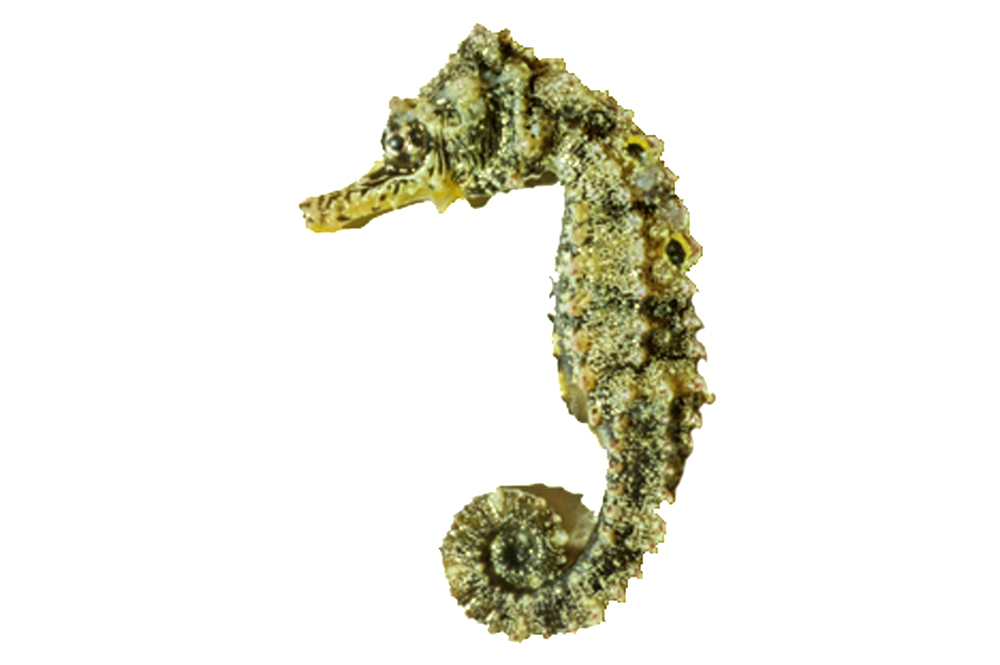False-eye Seahorse, Hippocampus biocellatus Kuiter 2001

A False-eye Seahorse, Hippocampus biocellatus. Source: Australian National Fish Collection, CSIRO. License: All rights reserved
A blotchy pale greyish to pale brown seahorse with blackish scribbles and fine yellowish-cream spots, two distinct black ocelli surrounded with yellow laterally on upper sides of the trunk, and two narrow dark stripes along the dorsal fin.
The pair of "eye spots" or ocelli on the back of the False-eye Seahorse may distract or confuse predators.
False-eye Seahorse, Hippocampus biocellatus Kuiter 2001
More Info
|
Distribution |
Endemic to the Shark Bay region to Exmouth Gulf, Western Australia. Inhabits algal reefs and seagrass beds in protected shallow bays from the intertidal zone to a depth of about 20 m. |
|
Features |
Dorsal fin 22-23; Pectoral fin 16-18; Anal fin 4-5 (rays divided at base); trunk rings; tail rings 36-38; subdorsal rings 3 + 1-2. Head moderately long; snout moderately long; nasal ridge slightly raised, spine absent; a thick membranous keel of skin present along edge of ventral trunk ridge. Coronet slightly raised, apex with 5 blunt diverging spines. Spine above eyes moderately large, angled back and laterally outward; lateral head spine moderately large, recurved; spines behind and below eye small; upper shoulder-ring spine small to moderate, beside gill opening; central shoulder ring spine small, tubercle-like, lower shoulder ring spine moderate, directed laterally outward; subdorsal spines 4-5/0,0,1,1; superior trunk and tail ridges with broad thorn-like blunt spines, enlarged at regular intervals on some rings; superior tail ridge with tubercle-like spines of moderate size, angled backward; trunk ridges and connecting tail ridges with spines and tubercles becoming gradually smaller posteriorly. |
|
Size |
Height to about 110 mm. |
|
Colour |
In life, body with blotched pale cream-grey to pale brown patterns, and blackish scribbles and fine yellowish cream spots; head often with thin black lines around eye and over operculum; two distinct black ocelli surrounded with yellow laterally on upper sides of the trunk, situated on enlarged superior ridge spines of 4th and 7th rings. Dorsal fin with two thin longitudinal dark lines, one along fin margin, the other through centre of fin. In preservative - similar to fresh material, with dark colours reddish-brown and black spots on back remaining distinct. |
|
Feeding |
Like other seahorses, this species presumably preys on small crustaceans and other small invertebrates by sucking them in through the tubular snout. |
|
Biology |
Sexes separate, reproduction a form of viviparity or ovoviviparity, whereby the males give birth to tiny independent young. The female uses an ovipositor to transfer her eggs into an elaborate enclosed pouch under the abdomen of the male. The male not only fertilizes the eggs inside the pouch and provides physical protection for the developing embryos, he also osmoregulates and aerates the embryos and may provide some nourishment until the offfspring are born. |
|
Fisheries |
No known international trade for the aquarium industry. |
|
Conservation |
CITES: Listed under Appendix II of the Convention on the International Trade in Endangered Species of Wild Flora and Fauna (CITES). |
|
Remarks |
Males have a deep keel-like skin membrane on the ventral trunk ridge that may be used during courtship displays. |
|
Similar Species |
H. biocellatus is similar to H. planifrons, differing in colour pattern and in having a longer, more slender trunk and generally smaller spines, especially subdorsally. |
|
Etymology |
Hippocampus is from the Greek, ippos = horse and kampe = curvature. The specific name biocellatus is from the Latin bi (two) and ocellus (eye) in reference to the eyelike spots on back. |
|
Species Citation |
Hippocampus biocellatus Kuiter 2001, Rec. Aust. Mus. 53: 311, fig. 15, Shark Bay, Western Australia. |
|
Author |
Bray, D.J. & Thompson, V.J. 2018 |
|
Resources |
False-eye Seahorse, Hippocampus biocellatus Kuiter 2001
References
Kuiter, R.H. 2000. Seahorses, Pipefishes and their Relatives. TMC Publishing, Chorleywood, UK, 240 pp.
Kuiter, R.H. 2001. Revision of the Australian Seahorse of the genus Hippocampus (Syngnathiformes: Syngnathidae) with descriptions of nine new species. Rec. Aust. Mus. 53: 293-340.
Pollom, R. 2017. Hippocampus planifrons. The IUCN Red List of Threatened Species 2017: e.T68527310A47728827. http://dx.doi.org/10.2305/IUCN.UK.2017-3.RLTS.T68527310A47728827.en. Downloaded on 21 June 2018. (H. biocellatus treated as a junior synonym of H. planitfrons)
Pogonoski, J.J., D.A. Pollard & J.R. Paxton. 2002. Conservation Overview and Action Plan for Australian Threatened and Potentially Threatened Marine and Estuarine Fishes. Canberra, Environment Australia, 375 pp.



